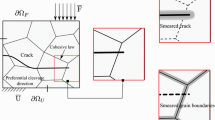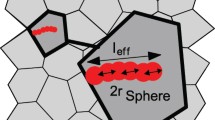Abstract
Micro-crack propagation in polycrystalline materials can strongly depend on the defect size and its ratio to specimen size, and local variation in the microstructural features such as grain orientation, size, etc. While the dependencies are understood heuristically, the use of mechanistic models to capture the effect of various factors influencing micro-crack propagation can enable accurate prediction of fracture properties of polycrystalline materials and their engineering. To this end, a crystal plasticity coupled to damage model for micro-crack propagation on cleavage planes has been developed in this work and is shown to successfully capture the grain orientation dependent growth. In order to identify a suitable integration scheme for the coupled model, a one-dimensional model is developed and a detailed comparative analysis of three different schemes is performed. The analysis shows that the coupled explicit–implicit scheme is the most suitable and is a key finding of this work. Subsequently, a two-scale multi-scale method has been developed to include the interaction between the defect, its surrounding microstructure and the specimen. The two-scale method along with the coupled crystal plasticity-damage model has been applied to perform finite element method based micro-crack growth simulations for a microstructurally short and physically long crack with two different microstructures with random orientation and texture. Such a study comparing microstructural effects on crack growth from pre-existing defects of drastically disparate sizes hasn’t been performed before and is a novelty of this work. The analyses clearly show that though the micro-crack path from long crack is different depending on the orientation distribution, the rates are nearly independent of the local behavior. Moreover, the micro-crack propagation rate from long crack is significantly larger at the initial stages, with the latter showing significant acceleration after a small growth. Overall, the influence of microstructure on the crack growth behavior is stronger for short cracks, which conform with experimental observations and is successfully captured by the proposed model.























Similar content being viewed by others
References
Bang D, Ince A (2020) A short and long crack growth model based on 2-parameter driving force and crack growth thresholds. Int J Fatigue 141:105870. https://doi.org/10.1016/j.ijfatigue.2020.105870
Benedetti I, Aliabadi M (2015) Multiscale modeling of polycrystalline materials: a boundary element approach to material degradation and fracture. Comput Methods Appl Mech Eng 289:429–453. https://doi.org/10.1016/j.cma.2015.02.018
Bilby BA, Cottrell AH, Swinden K (1963) The spread of plastic yield from a notch. Proc R Soc Lond A 272(1350):304–314. https://doi.org/10.1098/rspa.1963.0055
Bond D, Zikry M (2018) Differentiating between intergranular and transgranular fracture in polycrystalline aggregates. J Mater Sci 53:5786–5798. https://doi.org/10.1007/s10853-017-1847-2
Chan K, Lankford J (1988) The role of microstructural dissimilitude in fatigue and fracture of small cracks. Acta Metall 36(1):193–206. https://doi.org/10.1016/0001-6160(88)90038-7
Chen B, Pinho S, De Carvalho N, Baiz P, Tay T (2014) A floating node method for the modelling of discontinuities in composites. Eng Fract Mech 127:104–134. https://doi.org/10.1016/j.engfracmech.2014.05.018
Hussain K (1997) Short fatigue crack behaviour and analytical models: a review. Eng Fract Mech 58(4):327–354. https://doi.org/10.1016/S0013-7944(97)00102-1
Köster P, Knobbe H, Fritzen C-P, Christ H-J, Riedler M (2010) Simulation of stage I-short crack propagation in forged Ti6Al4V. Proc Eng 2(1):1701–1709. https://doi.org/10.1016/j.proeng.2010.03.183
Li Y, McDowell D, Zhou M (2014) A multiscale framework for predicting fracture toughness of polycrystalline metals. Mater Perform Charact 3(3):157–172. https://doi.org/10.1520/MPC20130064
Mao J, Hu D, Meng F, Zhou X, Song J, Wang R (2018) Multiscale modeling of transgranular short crack growth during fatigue in polycrystalline metals. Int J Fatigue 116:648–658. https://doi.org/10.1016/j.ijfatigue.2018.07.017
Miller K (1987) The behaviour of short fatigue cracks and their initiation part I–a review of two recent books. Fatigue Fract Eng Mater Struct 10(1):75–91. https://doi.org/10.1111/j.1460-2695.1987.tb01150.x
Pei C, Zeng W, Yuan H (2020) A damage evolution model based on micro-structural characteristics for an additive manufactured superalloy under monotonic and cyclic loading conditions. Int J Fatigue 131:105279. https://doi.org/10.1016/j.ijfatigue.2019.105279
Potirniche G, Daniewicz S (2003) Analysis of crack tip plasticity for microstructurally small cracks using crystal plasticity theory. Eng Fract Mech 70(13):1623–1643. https://doi.org/10.1016/S0013-7944(02)00204-7
Riehle N, Thude S, Kandelbauer A, Tovar GE, Lorenz G (2019) Synthesis of soft polysiloxane-urea elastomers for intraocular lens application. JoVE. https://doi.org/10.3791/58590
Roy U, McDowell DL, Zhou M (2021) Effect of grain orientations on fracture behavior of polycrystalline metals. J Mech Phys Solids 151:104384. https://doi.org/10.1016/j.jmps.2021.104384
Shanthraj P, Svendsen B, Sharma L, Roters F, Raabe D (2017) Elasto-viscoplastic phase field modelling of anisotropic cleavage fracture. J Mech Phys Solids 99:19–34. https://doi.org/10.1016/j.jmps.2016.10.012
Sun S (2014) Multiscale modeling of fracture in polycrystalline materials. PhD thesis. https://deepblue.lib.umich.edu/handle/2027.42/108936
Thondiraj JM, Paranikumar A, Tiwari D, Paquet D, Chakraborty P (2024) Diffused interface crystal plasticity finite element method: biased mesh generation and accuracy. Finite Elem Anal Des 228:104051. https://doi.org/10.1016/j.finel.2023.104051
Tokaji K, Ogawa T, Ohya K (1994) The effect of grain size on small fatigue crack growth in pure titanium. Int J Fatigue 16(8):571–578. https://doi.org/10.1016/0142-1123(94)90483-9
Tokaji K, Kamakura M, Ishiizumi Y, Hasegawa N (2004) Fatigue behaviour and fracture mechanism of a rolled az31 magnesium alloy. Int J Fatigue 26(11):1217–1224. https://doi.org/10.1016/j.ijfatigue.2004.03.015
Tu X, Ray A, Ghosh S (2020) A coupled crystal plasticity fem and phase-field model for crack evolution in microstructures of 7000 series aluminum alloys. Eng Fract Mech 230:106970. https://doi.org/10.1016/j.engfracmech.2020.106970
Wan V, MacLachlan D, Dunne F (2016) Integrated experiment and modelling of microstructurally-sensitive crack growth. Int J Fatigue 91:110–123. https://doi.org/10.1016/j.ijfatigue.2016.05.027
Wilson D, Zheng Z, Dunne FP (2018) A microstructure-sensitive driving force for crack growth. J Mech Phys Solids 121:147–174. https://doi.org/10.1016/j.jmps.2018.07.005
Wilson D, Zheng Z, Dunne FP (2018) A microstructure-sensitive driving force for crack growth. J Mech Phys Solids 121:147–174. https://doi.org/10.1016/j.jmps.2018.07.005
Wu J-Y, Nguyen VP, Nguyen CT, Sutula D, Sinaie S, Bordas SP (2020) Phase-field modeling of fracture. Adv Appl Mech 53:1–183. https://doi.org/10.1016/bs.aams.2019.08.001
Zhang P, Karimpour M, Balint D, Lin J (2012) Cohesive zone representation and junction partitioning for crystal plasticity analyses. Int J Numer Meth Eng 92(8):715–733. https://doi.org/10.1002/nme.4356
Acknowledgements
The authors acknowledge the sponsor Science and Engineering Research Board for funding this effort under the project CRG/2018/000174.
Author information
Authors and Affiliations
Corresponding author
Additional information
Publisher's Note
Springer Nature remains neutral with regard to jurisdictional claims in published maps and institutional affiliations.
Appendix: Numerical integration schemes
Appendix: Numerical integration schemes
1.1 Case 1: Fully implicit numerical integration scheme
The residual equations corresponding to Eqs. 18 to 22 are,
1.2 Case 2: Decoupled explicit–implicit numerical integration scheme
The residual equations and the Jacobian for the first loop are explained as follow,
where plastic strain increment is calculated as
The Jacobian is obtained as,
The stress, \(\sigma \), is updated following,
Once \(\left| R_{\sigma }\right| <\eta \), a chosen tolerance, the g is updated following
In the second loop, the variables \(\left( \phi \right) \) and \(\left( \Delta \varepsilon ^d\right) \) are updated using a similar approach as above where the residual and the Jacobian are as follows:
where
The Jacobian is obtained as,
The damage variable \(\phi \) is updated as follows,
1.3 Case 3: Coupled explicit–implicit numerical integration scheme
The residual \(R_{\sigma }\) and the Jacobian \(J_{\sigma }\) for the first loop are as follows,
where
are as given previous case.
and the stress is updated following
Once \(\left| R_{\sigma }\right| <\eta \), a predefined tolerance, the resistance stress g is updated following,
and damage variable \(\phi \) using
Rights and permissions
Springer Nature or its licensor (e.g. a society or other partner) holds exclusive rights to this article under a publishing agreement with the author(s) or other rightsholder(s); author self-archiving of the accepted manuscript version of this article is solely governed by the terms of such publishing agreement and applicable law.
About this article
Cite this article
Siddharth, S., Singh, S., Kazim, S.M. et al. Coupled crystal plasticity and damage model for micro crack propagation in polycrystalline microstructures. Int J Fract (2024). https://doi.org/10.1007/s10704-024-00772-9
Received:
Accepted:
Published:
DOI: https://doi.org/10.1007/s10704-024-00772-9




